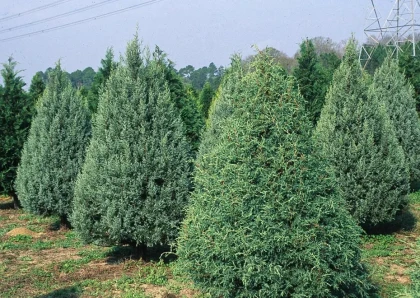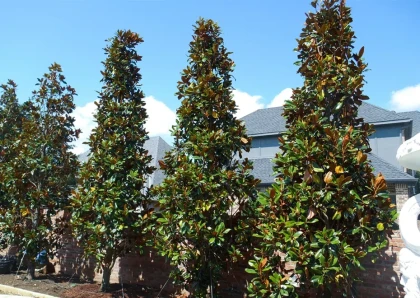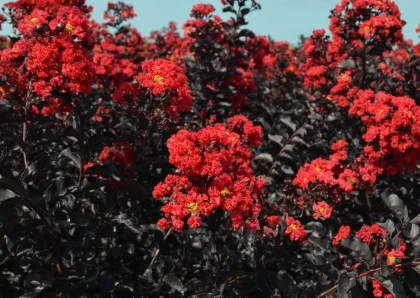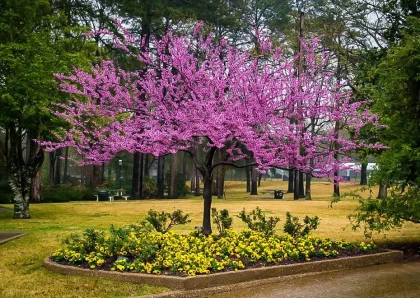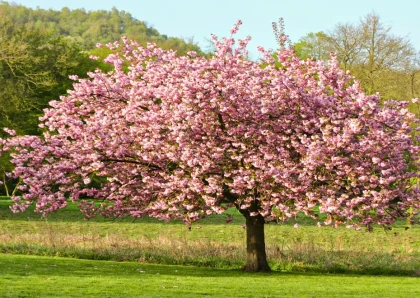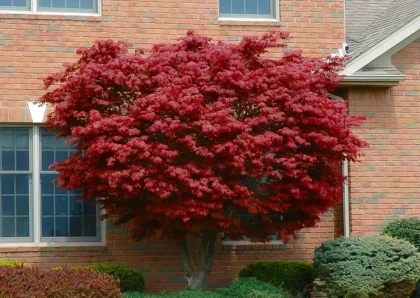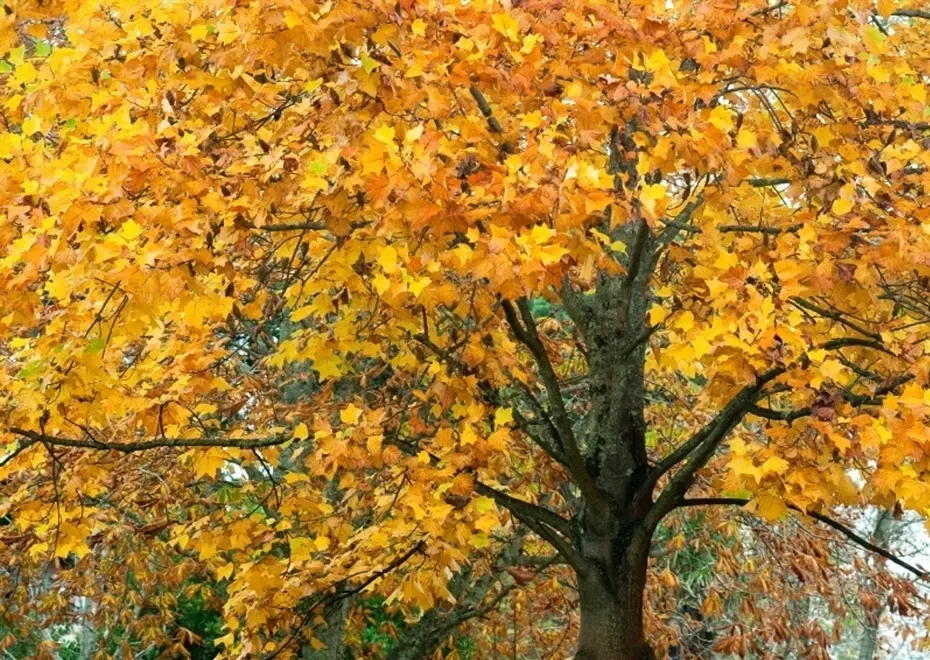
Tulip Poplar Tree
Overview
History of the Tree
The Tulip Poplar (Liriodendron tulipifera), also known as Yellow Poplar or Tulip Tree, is a majestic tree native to the eastern regions of North America. It has a rich history intertwined with the early settlers and indigenous peoples of the land. The tree's distinctive tulip-shaped flowers and its tall stature made it a symbol of beauty and resilience. The wood of the Tulip Poplar was highly valued and used for a variety of purposes, including construction, shipbuilding, and furniture-making.
Detailed Description of the Tree
The Tulip Poplar is a large, deciduous tree that can reach impressive heights of 80 to 120 feet (24 to 36 meters) or more. It features a straight, sturdy trunk with a smooth, grayish bark that becomes furrowed with age. The leaves are unique and easily recognizable, with a vibrant green color and a distinctive shape resembling tulip flowers, hence its name. The flowers themselves are striking, showcasing a combination of yellow, green, and orange hues. They appear in late spring to early summer and have a pleasant fragrance, attracting pollinators such as bees and hummingbirds.
Types of This Tree
There is one primary species of Tulip Poplar, Liriodendron tulipifera. However, within this species, there can be natural variations in terms of growth habit, leaf shape, and flower color. These variations add to the tree's diversity and appeal.
Importance of This Tree
The Tulip Poplar holds significant ecological, economic, and cultural importance:
- Ecologically, it provides valuable habitat for a wide range of wildlife species, including birds and mammals. Its flowers serve as a vital food source for bees and butterflies.
- Economically, the wood of the Tulip Poplar is highly valued for its strength, versatility, and resistance to decay. It has been historically used in construction, furniture-making, cabinetry, and veneer production.
- Culturally, the tree holds symbolic value and has been celebrated in literature, art, and folklore, representing strength, beauty, and the spirit of the land.
How to Care for This Tree
To ensure the health and vitality of a Tulip Poplar, consider the following care guidelines:
- Plant the tree in a location that provides well-drained soil and receives full or partial sunlight.
- Water the tree regularly, especially during dry periods, to keep the soil consistently moist but not waterlogged.
- Apply a layer of organic mulch around the base of the tree, maintaining a distance from the trunk, to help retain moisture and suppress weed growth.
- Prune the tree during its dormant season to remove any dead, damaged, or crossing branches. This helps maintain the tree's shape and promotes air circulation.
- Monitor the tree for pests and diseases, such as aphids or scale insects, and take appropriate measures to control any infestations.
Benefits of the Tree
The Tulip Poplar offers numerous benefits to both the environment and humans:
- Its large size and dense foliage provide excellent shade, reducing energy costs by keeping buildings cooler during hot summer months.
- The vibrant flowers attract pollinators, contributing to the health and diversity of ecosystems.
- The wood of the Tulip Poplar is highly valued for its strength and workability, making it suitable for a wide range of woodworking projects.
- The tree contributes to carbon sequestration, helping mitigate climate change by absorbing and storing carbon dioxide.
How to Plant This Tree
Follow these steps to successfully plant a Tulip Poplar tree:
- Choose a suitable planting location with well-drained soil and ample space for the tree to grow and spread its branches.
- Dig a hole that is wider and slightly deeper than the tree's root ball.
- Place the tree in the hole, ensuring that the root collar (the point where the roots meet the trunk) is level with or slightly above the ground surface.
- Backfill the hole with soil, gently firming it around the roots to eliminate air pockets.
- Water the tree thoroughly after planting and provide regular watering during the first few years until it establishes a strong root system.
Different Types of Wood Products That Can Be Made From This Tree
Tulip Poplar wood is highly versatile and used in various woodworking applications:
- Construction: The wood is used for framing, flooring, siding, and interior millwork due to its strength and durability.
- Furniture-making: Tulip Poplar is a popular choice for crafting furniture, cabinets, and veneers, known for its workability and attractive appearance.
- Boatbuilding: Its resistance to decay makes it suitable for boat construction, particularly for hulls and interior components.
- Musical instruments: Tulip Poplar wood is sometimes used in the construction of guitars, ukuleles, and other stringed instruments due to its tonal properties.
Cons
While the Tulip Poplar offers numerous benefits, it is important to consider the following potential drawbacks:
- The tree can be susceptible to certain diseases, such as cankers and leaf spot, which may affect its overall health and appearance.
- Its large size makes it unsuitable for smaller yards or confined spaces, requiring ample room for its growth and development.
- Regular pruning may be necessary to maintain its shape and remove any dead or damaged branches.
FAQs
1. How long does it take for a Tulip Poplar tree to reach maturity?
A Tulip Poplar tree typically reaches maturity within 15 to 20 years under optimal growing conditions. However, it may take longer in less favorable environments.
2. Does the Tulip Poplar tree require specific soil conditions?
Tulip Poplars prefer well-drained soils but can tolerate a range of soil types, including clay, loam, and sandy soils. However, they thrive best in moist, fertile soils.
3. Can I grow a Tulip Poplar tree from seeds?
Yes, it is possible to grow Tulip Poplar trees from seeds. However, they have specific requirements for breaking seed dormancy and often require a period of stratification (exposure to cold, moist conditions) before germination. Alternatively, purchasing young saplings from nurseries is a more convenient option.
4. Are Tulip Poplar trees prone to pests?
Tulip Poplars are generally resistant to pests and diseases. However, they can occasionally attract aphids, scale insects, and caterpillars. Regular monitoring and appropriate pest control measures, if needed, can help maintain the tree's health.
No listings available
Related Products
Questions & Answers
What do you want to know about this product?
Reviews (5)
LeafMaster42
A Majestic Beauty That Stands Tall
The Tulip Poplar's towering height and vibrant flowers make it a captivating centerpiece in any landscape. A true testament to nature's grandeur.
ArborealEnthusiast99
Nature's Masterpiece in My Backyard
The Tulip Poplar's tulip-shaped leaves and stunning flowers add a touch of elegance to my garden. It's a showstopper throughout the seasons.
TreeCraftsman78
Beauty and Functionality in One Tree
The Tulip Poplar's strong and versatile wood is perfect for my woodworking projects. Plus, its majestic presence enhances the beauty of my landscape.
WildlifeWatcher23
A Haven for Wildlife and Eyes
The Tulip Poplar's abundant foliage and nectar-rich flowers attract a diverse range of birds and pollinators. It's a nature lover's paradise!
Nature's Towering Beauty
The Tulip Poplar's impressive height and graceful form make it a standout tree. It's a symbol of strength and beauty in my backyard.






